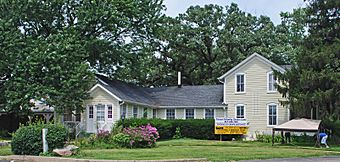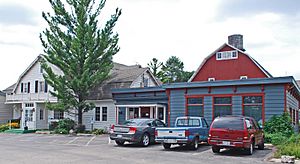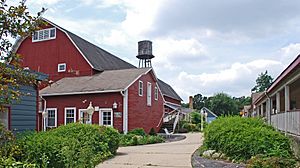Milk Pail Restaurant facts for kids
Quick facts for kids |
|
|
Country Tea Room
|
|

Original County Tea Room from the 1860s
|
|
| Location | 14N630 IL 25 Dundee Township, Kane County, Illinois, United States |
|---|---|
| Built | 1860s |
| Architectural style | Gablefront house |
| NRHP reference No. | 99000164 |
| Added to NRHP | February 25, 1999 |
The Milk Pail Restaurant is a special old restaurant in Dundee Township, Illinois. It used to be called the Country Tea Room. This building started as a farmhouse in the 1860s. A man named Increase C. Bosworth owned it and used it as a creamery, which is a place where milk products are made.
Later, in 1926, a businessman named Max McGraw bought the farm. He turned the farmhouse into a cozy teahouse restaurant. As more people started traveling by car in the 1930s, the restaurant changed to offer more food options. It even served special dishes with game (like wild birds or animals) from McGraw's nearby game preserve. The main building of the Milk Pail Restaurant was added to the National Register of Historic Places in 1999. This means it's an important historical site.
A Look Back in Time
The area around the Fox River in northern Illinois was first settled in the 1830s. People living there first made money from the land's natural resources. Later, the area grew to include factories and even got train connections to Chicago.
Increase C. Bosworth, a rich businessman from Chicago, moved to this area in 1837. In 1860, he bought a large piece of land, about 136 acres. By the 1860s, he had built a farm there. It included a farmhouse, a windmill, and a creamery. The house was built in a style called gablefront, with some fancy Italianate details.
The Roadside Restaurant Era
In the early 1900s, Illinois State Route 25 was planned. This new road would run along the east side of the Fox River, connecting towns like Oswego and Algonquin. Bosworth's farm was right next to where the new highway would be.
Max McGraw saw a great chance to start a business there. He bought the property in 1926. McGraw was becoming very wealthy from his successful Toastmaster products, like toasters. He added a new section to the building that same year.
Route 25 opened in 1929. The Country Tea Room, like many roadside restaurants back then, became very popular. The road was important for shipping dairy products. It also helped tourists travel north to Wisconsin. Customers loved toasting their own bread with McGraw's toasters. Some even bought Toastmasters for their homes!
When the restaurant first opened, car travelers didn't have many dining choices. They could either have a picnic or eat at fancy hotels. Roadside restaurants like the Country Tea Room filled this need for more options in the 1920s and 1930s. McGraw also kept the farm's dairy business going until 1939.
Becoming the Milk Pail
By the late 1930s, many roadside restaurants had popped up along major highways. To stay popular, restaurants needed to offer something special. The Country Tea Room at first found this change difficult. But it soon changed its name to the Milk Pail Restaurant. It became a full restaurant with unique main dishes.
Part of the property was turned into "The Fin 'n Feather Catalogue." This business sold smoked game, which was also featured on the Milk Pail menu. McGraw bought more land around the restaurant. He named it the McGraw Wildlife Foundation and opened it as a private game preserve. This was a place where wild animals were protected and could be hunted in a controlled way.
The main building of the Milk Pail Restaurant was officially added to the National Register of Historic Places on February 25, 1999. Today, the Milk Pail is still open. It is a popular spot for local events, especially wedding receptions.
Building Details
The original farmhouse faces east. The addition built in 1926 faces south. The old barn, creamery, and stable from the farm are still standing nearby. However, they have been changed a lot over the years. They are not considered part of the building's historical value.
A parking lot is located to the north and east of the main building. The two-story house has a small one-story addition that was built before the early 1900s. The Country Tea House extension from 1926 was built on the west side of the house. The house is made of wood panels and sits on a stone foundation. There is a chimney on the north side of the building. The windows on the east and south sides have wooden decorations called pediments. The windows on the north side do not. The roof is covered with asphalt shingles.





